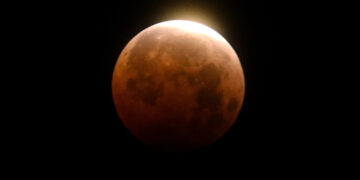The night sky is about to put on a stunning display, and you don’t want to miss it! On the night of March 13–14, 2025, a total lunar eclipse will occur, turning the full moon a deep, coppery red in what’s commonly called a “Blood Moon.”
What Is a Total Lunar Eclipse?
A total lunar eclipse happens when the Earth moves directly between the Sun and the Moon, casting its shadow onto the Moon’s surface.
During this alignment, the Moon does not disappear but instead takes on a reddish hue. This is because some sunlight still reaches the Moon but passes through Earth’s atmosphere, which filters out blue wavelengths and lets the red and orange light scatter onto the lunar surface.
This reddish glow is why total lunar eclipses are often called “Blood Moons.” The color and intensity can vary depending on atmospheric conditions, including dust, pollution, or volcanic ash in the air.
Why Does the Moon Turn Red?
The reason the Moon glows red instead of going completely dark is due to a phenomenon called Rayleigh scattering, the same effect that makes the sky appear blue and sunsets appear red.
When sunlight passes through Earth’s atmosphere, shorter blue and violet wavelengths scatter in all directions, while longer red and orange wavelengths bend around the Earth and reach the Moon. This results in the blood-red coloration seen during a total lunar eclipse.
In fact, if you were standing on the Moon during the eclipse, you would see the Earth blocking the Sun, surrounded by a thin ring of red light—the combined glow of all the sunrises and sunsets happening on Earth at that moment!
Where and When to See the March 2025 Lunar Eclipse
This total lunar eclipse will be visible across much of the Western Hemisphere, including North and South America, with the best views in areas with clear, dark skies.
For those in Europe and Africa, only the early stages of the eclipse may be visible before the Moon sets. Meanwhile, Asia and Australia will miss this eclipse but can look forward to another one in September 2025.
Here’s the timeline of the eclipse in Eastern Time (ET):
- Penumbral Eclipse Begins: 11:57 p.m. on March 13
- Partial Eclipse Begins: 1:09 a.m. on March 14
- Total Eclipse Begins: 2:26 a.m.
- Maximum Eclipse (Deepest Red Color): 2:58 a.m.
- Total Eclipse Ends: 3:31 a.m.
- Partial Eclipse Ends: 4:47 a.m.
- Penumbral Eclipse Ends: 5:59 a.m.
The most dramatic moment will be between 2:26 a.m. and 3:31 a.m., when the Moon is completely covered in Earth’s shadow and glows red.
How to Watch the Lunar Eclipse
One of the best things about a lunar eclipse is that you don’t need any special equipment to see it. Unlike a solar eclipse, which requires protective glasses, a lunar eclipse is completely safe to observe with the naked eye.
However, for the best viewing experience, consider the following:
- Find a Dark Location: The eclipse will be more vivid in areas away from city lights and light pollution.
- Check the Weather: A clear sky is essential for a good view. Monitor weather conditions leading up to the eclipse.
- Use Binoculars or a Telescope: While not necessary, these can enhance your view, allowing you to see surface details on the Moon.
- Photography Tips: If you want to capture the eclipse, use a camera with manual settings, adjusting exposure to highlight the Moon’s deep red glow.
Lunar Eclipses in History and Culture
Throughout history, lunar eclipses have been viewed as mystical and symbolic events. Many ancient civilizations saw them as omens or messages from the gods.
- Ancient Mesopotamians believed that a blood-red Moon was a bad omen for their king. To protect him, they sometimes placed a temporary “substitute king” on the throne during an eclipse.
- Aristotle (4th century BCE) noticed that the Earth’s shadow on the Moon was always curved, using lunar eclipses as proof that the Earth is round.
- Some Indigenous cultures saw a lunar eclipse as a battle between cosmic forces, with stories explaining that the Moon was being swallowed by a celestial creature before reappearing.
Today, we understand the science behind lunar eclipses, but their beauty and symbolism still captivate people worldwide.
Scientific Significance of Lunar Eclipses
Beyond their stunning beauty, lunar eclipses provide valuable scientific insights.
- Studying Earth’s Atmosphere: The way sunlight filters through Earth’s atmosphere can help scientists analyze atmospheric composition, pollution, and even volcanic activity.
- Exoplanet Research: Observing how light bends around Earth during an eclipse helps astronomers study how planets around other stars might behave when they pass in front of their suns.
- Verifying Einstein’s Theories: Lunar eclipses help test gravitational models and further our understanding of celestial mechanics.
Each eclipse offers a new opportunity for scientists, astronomers, and photographers to study the interaction between the Sun, Earth, and Moon.
When Is the Next Total Lunar Eclipse?
If you miss this eclipse, don’t worry! There will be another total lunar eclipse on September 7, 2025, visible across Asia, Africa, Australia, and parts of Europe.
For those in the Americas, the next total lunar eclipse will occur in March 2026. However, partial lunar eclipses and penumbral eclipses occur more frequently, so there are always chances to witness these fascinating events.
Conclusion: A Celestial Event Not to Be Missed
The total lunar eclipse on March 13–14, 2025, is set to be one of the year’s most breathtaking astronomical events. Whether you’re an avid stargazer, a casual observer, or simply someone who loves the wonders of the night sky, this Blood Moon will be a sight to remember.



















